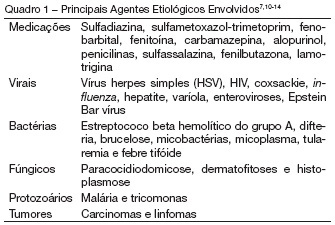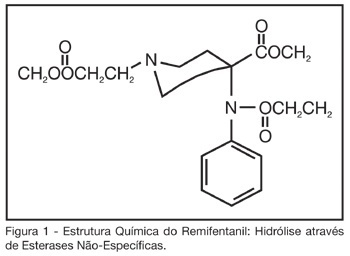Abstract
Rev Bras Ter Intensiva. 2006;18(3):292-297
DOI 10.1590/S0103-507X2006000300012
BACKGROUND AND OBJECTIVES: The Stevens Johnson Syndrome (SJS) and Toxical Epidermal Necrolisys (TEN) are important skin and mucosal lesions that need intensive care treatment. The aim of this article is to show a literature review about SJS and TEN. CONTENTS: This article reviews the concepts, diagnostic topics, clinical presentation and the principle of basic treatment in Intensive Care Unit for SJS and TEN. CONCLUSIONS: These illnesses are characterized as dermatological emergencies and its adequate management and cares must be part of the routine knowledge of the intensive care doctors.

Abstract
Rev Bras Ter Intensiva. 2006;18(2):186-189
DOI 10.1590/S0103-507X2006000200012
BACKGROUND AND OBJECTIVES: Critically ill patients frequently need to use sedative and analgesic drugs, as part of their treatment or during several procedures. It is a challenge for all intensive care providers to determine the best drug to be used for each patient, with less collateral effects. The objective of this study is to describe the background to give the use of remifentanil in intensive care clinical practice. CONTENTS: Remifentanil is a short acting opioid agonist little used in intensive care medicine. Several studies have been published, showing that remifentanil is a safe drug to be used for the sedation and analgesia for intensive care patients, still needing more information regardless to septic shock patients. CONCLUSIONS: Because remifentanil is a relatively new drug, it is not yet part of the routine drugs used for intensive care providers, although solid evidences of its safety and efficiency for critically ill patients.

Abstract
Rev Bras Ter Intensiva. 2006;18(4):385-389
DOI 10.1590/S0103-507X2006000400011
BACKGROUND AND OBJECTIVES: The progressive increasing diagnostic resources had influenced the quality and quantity of laboratory exams. It is not clear if the amount of exams performed influence the morbidity and mortality in the ICU patients. The purpose of this study was to appraise the frequency of the most ordering tests in the ICU of HU-UFSC and to check if there was connection between them and the age, the destiny until the ICU discharge and the estimate severity of their diseases. METHODS: Prospective cohort study with qualitative approach. The blood samples of admitted patients were analyzed, from July to December 2005. Clinical and demographic features were collected and the most frequently blood-samples were quantified per day. In the sequence the daily rate of exams were calculated during all the admission period. The patients were analyzed according to three criterions: age, destiny until the ICU discharge and estimate severity according to APACHE II index. Data were analyzed using Fisher Exact, Chi-square and ANOVA tests. RESULTS: One hundred and thirteen patients were enrolled to this study. The average test-ordering was 11.50 per day. These numbers didn't have statistical difference when they were compared between survivor and non-survivor patients, and between those whose the death estimated tax was bigger or smaller than 50 per cent. CONCLUSIONS: The test-ordering didn't show clinical and prognostic relation to its request. There were no statistic relation between the patient's age, ICU discharge and the estimate severity.
Abstract
Rev Bras Ter Intensiva. 2007;19(1):60-66
DOI 10.1590/S0103-507X2007000100008
BACKGROUND AND OBJETIVES: To evaluate the quality and satisfaction of life (QSL) of patients before admission in ICU, and after hospital discharge. To verify the influence of the patient's demographic/clinic/therapeutic factors in the QSL. METHODS: Prospective cohort study with quali-quantitative approach. All patients admitted in ICU/HU/UFSC from April-July 2005, who's stayed more than 24 hours were included. Initially, the data of QSL before ICU admission, patient's demographics/clinics/therapeutics features were recorded. Afterwards, by telephone, 7, 90 and 180 days after hospital discharge, the patients answered the questionnaires about QSL. In the sequence, all patients were subdivided into 2 main groups: unchanged or better, and worse QSL. Data were analyzed using t Student and Chi-square tests (p-value < 0.05). RESULTS: Sixty eight patients were enrolled into the study. Completed questionnaires were obtained from 21 of them. A comparison of 7, 90 and 180 days after hospital discharge showed that QSL of patients was unchanged or better at 90 and 180 days. The majority of patients expressed more satisfaction in that moment. Unchanged or better QSL was associated with advanced age. However, there were no statistical significant differences in sex, schooling, APACHE II score, length of stay, mechanical ventilation and used drugs. Sixty percent returned to their previous work. CONCLUSIONS: There was a tendency for patients who felt themselves satisfied after hospital discharge to have their QSL improved as time went bye. Better QSL was associated with advanced age. Even when patients reported worse QSL they returned to their previous work.
